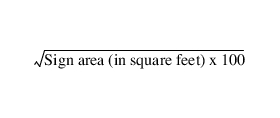31.230 Electronic Message Displays.
(1) Findings. The Common Council makes the following findings regarding electronic message displays (EMDs):
(a) Electronic displays are designed to produce sufficient brightness to ensure clear legibility during daylight hours. However, daytime brightness settings are inappropriate for night-time viewing.
(b) Electronic displays that are too bright at night can be offensive and reduce the legibility of the display copy.
(c) Technology exists to control lighting levels, with scheduled dimming based on sunset-sunrise tables or with photocells.
(d) Appropriate standards are necessary to ensure electronic displays do not become a nuisance to surrounding property owners or pedestrians or a distraction to passing motorists.
(2) General Standards. An electronic message display when allowed by this chapter must comply with the following minimum standards:
(a) An electronic message display must be equipped with technology the sign owner can use to program lighting levels to comply with the lighting standards in this section (i.e., automatic dimming).
(b) Except for time and temperature displays, the message shall remain static at least seven seconds before the next message appears.
(c) No part of the message can flash, fade in or out, or otherwise create the appearance of movement.
(d) There shall be no transition between messages (i.e., no traveling, scrolling, dissolving, or fading).
(e) Lighting levels shall not exceed 0.3 footcandles over ambient lighting conditions when measured at the specified distance in the table below, based on the size of the display. However, lighting levels shall not exceed 0.1 footcandles over ambient lighting conditions at the property boundary line of a residential property or 0.2 footcandles over ambient lighting conditions at the property boundary line of a commercial, industrial, or institutional property.
The publication titled “Night-time Brightness Level Recommendations for On-Premise Electronic Message Centers,” as published by the International Sign Association, describes how lighting levels are to be measured. A copy of this publication is available from the Building Inspector.
|
Sign Area (square feet) |
Measurement Distance (feet) |
|---|---|
|
10 |
32 |
|
15 |
39 |
|
20 |
45 |
|
25 |
50 |
|
30 |
55 |
|
35 |
59 |
|
40 |
63 |
|
Note: The sign areas listed in this table are for illustration only. The City’s sign regulations may not allow the sign areas listed. For sign areas not listed, the measurement distance is calculated with the following formula: Measurement of distance = |
|
(f) The electronic message display must be turned off by 11:00 p.m. each day or one hour after the close of the business on the premises whichever is later and shall remain off until 5:00 a.m. or one hour before the business is open, whichever is earlier, the following day.
(g) An electronic message display may not be located on more than one sign (i.e., one per parcel).
(h) By installing an electronic message display the property owner agrees to cooperate with the Building Inspector in testing the illuminance of the display.
(i) An electronic message display must be placed, designed, and constructed to be an integral part of the sign to which it is attached.
(j) An electronic message display must be located more than 100 feet from an electronic message display on an adjoining parcel.
(k) The Building Inspector has the authority to grant or rescind exceptions to these standards, at his or her sole discretion, and only when safety concerns are not at issue.
[Ord. 24-1121 § 2, 2024; Ord. 21-601 § 1, 2021]



